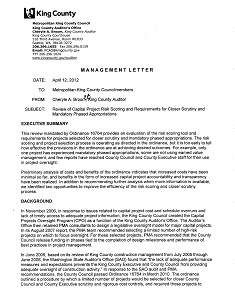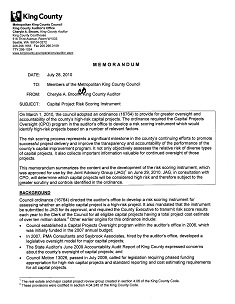Review of capital project risk scoring and requirements for closer scrutiny and mandatory phased appropriations
April 12, 2012
This review was required by Ordinance 16764 to evaluate a process designed to increase legislative oversight of capital projects. The process came to be known as Mandatory Phased Appropriation, referring to one of the main elements of legislative scrutiny imposed on projects selected as needing enhanced oversight. The Capital Projects Oversight group within the Auditor’s Office developed a tool to assess risks to cost, scope, and schedule for capital projects with a total project cost estimate exceeding $10 million. Agencies scored 35 projects in the first two rounds in 2010 and 2011, and the Joint Advisory Group (a body of senior executive and legislative branch officials) selected 15 for closer scrutiny and mandatory phased appropriations. This review represents the first analysis of the new requirements for identifying, managing, and reporting on projects selected for closer scrutiny and mandatory phased appropriations.
The risk scoring and project selection process is operating as directed in the ordinance, but it is too early to tell how effective the provisions in the ordinance are at achieving desired outcomes. For example, only one project has experienced mandatory phased appropriations, some are not using earned value management, and few reports have reached County Council and County Executive staff for their use in project oversight. Preliminary analysis of costs and benefits of the ordinance indicates that increased costs have been minimal so far, and benefits in the form of increased capital project accountability and transparency have been realized. In addition to recommending further analysis when more information is available, we identified two opportunities to improve the efficiency of the risk scoring and closer scrutiny process.
The Auditor has followed up on the report to evaluate implementation of our recommendations. See the most updated information below.
Of the 3 recommendations:
| DONE | 1 | Recommendations have been fully implemented. Auditor will no longer monitor. |
|---|---|---|
| PROGRESS | 0 | Recommendations are in progress or partially implemented. Auditor will continue to monitor. |
| OPEN | 0 | Recommendations remain unresolved. Auditor will continue to monitor. |
| CLOSED | 2 | Recommendations are no longer applicable. Auditor will no longer monitor. |
Summary
This management letter represents the first analysis of the new capital project risk scoring procedure and requirements for increased legislative scrutiny. Our objectives were to (1) evaluate the functionality and efficacy of a tool developed to assess risk of cost, scope, or schedule overruns, (2) evaluate the extent to which agencies responsible for selected capital projects are implementing new requirements related to project scoring, management, and reporting, (3) identify any benefits to agencies, the County Council, the County Executive, and/or Capital Projects Oversight of the new scoring and reporting requirements, (4) identify any challenges and/or costs associated with implementing these requirements, and (5) briefly assess the project phase descriptions and data requirements for appropriation and lease requests for lease-based projects. This was a limited non-audit review.
Key audit findings included:
- The risk scoring tool functions well and meets specifications, but correlation to project performance remains unproven
- Most agencies do not use earned value management and some required reports were not filed, but agencies are otherwise ready to comply with requirements
- The ordinance benefited the County Council and County Executive by providing mechanisms for oversight and encouraging countywide project management improvements
- The risk scoring process and requirements for selected projects have resulted in minimal cost increases so far
- Requirements for lease-based projects codify current practices.
To further assess and improve the effectiveness and efficiency of the requirements in Ordinance 16764, we recommend the following three actions:
- As part of their programmatic work, CPO should conduct additional analysis as more data become available to monitor the effectiveness of the ordinance.
- The County Executive should conduct further assessment of and training on best uses of Earned Value Management in managing the county’s capital projects.
- The County Council and County Executive should ensure agencies are aware of the process for removing closer scrutiny and mandatory phased appropriations from projects where updated scores show substantially diminished risk.
Reports related to this audit
Follow-up reports for this project are not available.
Audit team
Laina Poon and Larry Brubaker conducted this audit. If you have any questions or would like more information, please call the King County Auditor's Office at 206-477-1033 or contact us by email KCAO@kingcounty.gov.

 Translate
Translate

